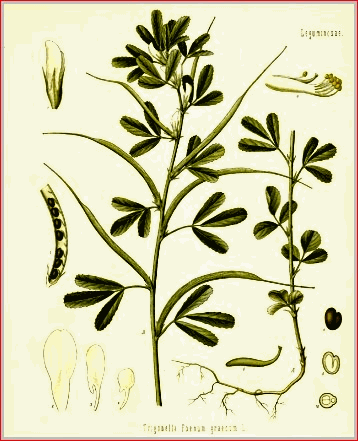
 FENUGREEK
- Trigonella Foenum-graecum L.
FENUGREEK
- Trigonella Foenum-graecum L.
A Modern Herbal. Mrs. M. Grieve. F.R.H.S.
Compiled by Ivor Hughes.
United States Dispensatory 1926 Part II
A low European annual herb with pinnately 3-foliate leaves, obscurely dentate, obovate, leaflets and white flowers, cultivated in southern Europe, northern Africa and India for its seeds. These are oblong-quadrangular, somewhat compressed, obliquely truncated at each extremity, 3 to 5 mm. in length and 2 mm. broad, brownish-yellow externally, internally yellow, and marked with an oblique furrow running half their length.
They have a strong peculiar odor
resembling that of elm bark, and an oily, bitter, farinaceous taste, and
contain fixed and volatile oils, mucilage, bitter extractive and a yellow
coloring substance. E. Jahns (B. Chem., 1886, xviii and 1887, xx, p. 2840)
has obtained choline, and trigonelline, C7H702N.
The yield of the former was 0.05 per cent., and of the latter 0.13 per cent.
Trigonelline is a betaine of nicotinic acid. It is found in several other
plants and appears to be the same as caffearine found in coffee (Gorier, Ann.
Chem., 1910, ccclxxii, 237). An ounce of the seeds, boiled in a pint of
water, renders it thick and slimy. They yield the whole of their odor and
taste to alcohol. On the continent of Europe they are employed in the
preparation of emollient cataplasms, enemata, ointments and plasters. They
are never used internally for human beings, but the ground seeds are used to
an enormous extent in the manufacture of cattle powders or condition powders
and the decoction or fluidextract for making imitation maple flavor.
A Modern Herbal. Mrs. M. Grieve. F.R.H.S
N.O. Leguminosae
Synonyms. Bird's Foot. Greek Hay-seed
Part Used. Seeds
Habitat. Indigenous to the countries on the eastern shores of the Mediterranean. Cultivated in India, Africa, Egypt, Morocco, and occasionally in England
Description: The name comes from Foenum-graecum, meaning Greek Hay, the plant being used to scent inferior hay. The name of the genus, Trigonella, is derived from the old Greek name, denoting 'three-angled,' from the form of its corolla. The seeds of Fenugreek have been used medicinally all through the ages and were held in high repute among the Egyptians, Greeks and Romans for medicinal and culinary purposes. Fenugreek is an erect annual herb, growing about 2 feet high, similar in habit to Lucerne. The seeds are brownish, about 1 inch long, oblong, rhomboidal, with a deep furrow dividing them into two unequal lobes. They are contained, ten to twenty together, in long, narrow, sickle-like pods.
Taste, bitter and peculiar, not unlike lovage or celery.
Odour, similar.
Constituents. About 28 per cent, mucilage; 5 per cent, of a stronger-smelling, bitter fixed oil, which can be extracted by ether; 22 per cent, proteids; a volatile oil; two alkaloids, Trigonelline and Choline, and a yellow colouring substance. The chemical composition resembles that of cod-liver oil, as it is rich in phosphates, lecithin and nucleo-albumin, containing also considerable quantities of iron in an organic form, which can be readily absorbed. Reutter has noted the presence of trimethylamine, neurin and betain; like the alkaloids in cod-liver oil, these substances stimulate the appetite by their action on the nervous system, or produce a diuretic or ureo-poietic effect.
Medicinal Action and Uses. In Cairo it is used under the name of Helba. This is an Egyptian preparation, made by soaking the seeds in water till they swell into a thick paste. Said to be equal to quinine in preventing fevers; is comforting to the stomach and has been utilized for diabetes. The seeds are soaked in water, then allowed to sprout, and when grown about 2 or 3 inches high, the green eaten raw with the seeds.
The seeds yield the whole of their odour
and taste to alcohol and are employed in the preparation of emollient
cataplasms, ointments and plasters.
They give a strong mucilage, which is emollient and a decoction of 1 oz.
seeds to 1 pint water is used internally in inflamed conditions of the
stomach and intestines. Externally it is used as a poultice for abscesses,
boils, carbuncles, etc. It can be employed as a substitute for cod-liver oil
in scrofula, rickets, anaemia, debility following infectious diseases. For
neurasthenia, gout and diabetes it can be combined with insulin. It
possesses the advantage of being cheap and readily taken by children, if its
bitter taste is disguised: 1 or 2 teaspoonful of the powder is taken daily
in jam, etc.
The ground seeds are used also to give a maple-flavouring to confectionery and nearly all cattle like the flavour of Fenugreek in their forage. The powder is also employed as a spice in curry. At the present day, the ground seeds are utilized to an enormous extent in the manufactures of condition powders for horses and cattle; Fenugreek is the principal ingredient in most of the quack nostrums which find so much favour among grooms and horse keepers. It has a powerful odour of coumarin and is largely used for flavouring cattle foods and to make damaged hay palatable. In India the fresh plant is employed as an esculent.
Other Species. Trigonella purpurascens, a British species, with small pinky-white flowers, one to three together, and straight, six- to eight-seeded pods, twice as long as the calyx.
If you did not find what you were seeking use the site search box at the top right hand of the page or else peruse the site library.
![]()